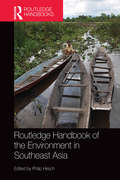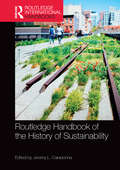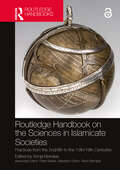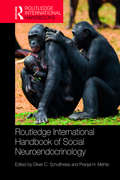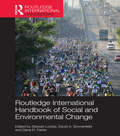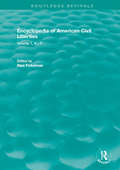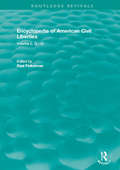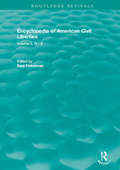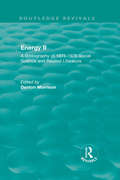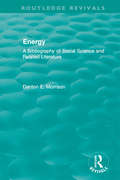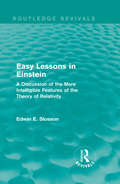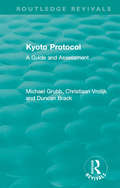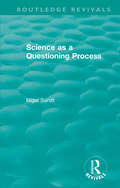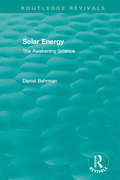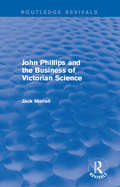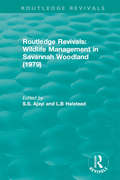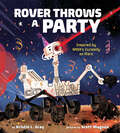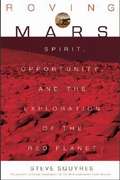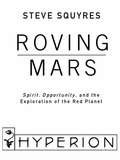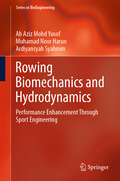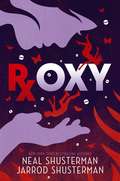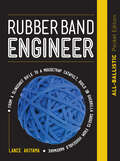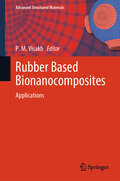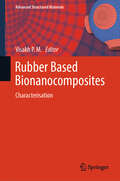- Table View
- List View
Routledge Handbook of the Environment in Southeast Asia
by Philip HirschThe environment is one of the defining issues of our times, and it is closely linked to questions and dilemmas surrounding economic development. Southeast Asia is one of the world’s most economically and demographically dynamic regions, and it is also one in which a host of environmental issues raise themselves. The Routledge Handbook of the Environment in Southeast Asia is a collection of 30 chapters dealing with the most significant scholarly debates in this rapidly growing field of study. Structured in four main parts, it gives a comprehensive regional overview of, and insight into, the environment in Southeast Asia. Wide-ranging and balanced, this handbook promotes scholarly understanding of how environmental issues are dealt with from diverse theoretical perspectives. It offers a detailed empirical understanding of the myriad environmental problems and challenges faced in Southeast Asia. This is the first publication of its kind in this field; a helpful companion for a global audience and for scholars of Southeast Asian studies from a variety of disciplines.
Routledge Handbook of the History of Sustainability (Routledge Environment and Sustainability Handbooks)
by Jeremy L. CaradonnaThe Routledge Handbook of the History of Sustainability is a far-reaching survey of the deep and contemporary history of sustainability. This innovative resource will help to define the history of sustainability as an identifiable field. It provides a unique resource for advanced undergraduates, graduate students, and scholars, and delivers essential context for understanding the current state and future path of the sustainability movement. The history of sustainability is an increasingly important domain within the discipline of history, which draws on an interdisciplinary set of fields, ranging from energy studies, transportation, and urbanism to environmental history, economics, and philosophy. Key sections in this handbook cover the historiography of sustainability, resilience and collapse in historical societies, the deep roots of sustainability (seventeenth century to nineteenth century), the recent history of sustainability (twentieth century to present), and core issues and key debates in sustainability. This handbook is an invaluable research and teaching tool for those interested in the history and development of sustainability and an essential resource for the many sustainability studies programs that now exist in the world's universities.
Routledge Handbook on the Sciences in Islamicate Societies: Practices from the 2nd/8th to the 13th/19th Centuries
by Sonja BrentjesThe Routledge Handbook on the Sciences in Islamicate Societies provides a comprehensive survey on science in the Islamic world from the 8th to the 19th century. Across six sections, a group of subject experts discuss and analyze scientific practices across a wide range of Islamicate societies. The authors take into consideration several contexts in which science was practiced, ranging from intellectual traditions and persuasions to institutions, such as courts, schools, hospitals, and observatories, to the materiality of scientific practices, including the arts and craftsmanship. Chapters also devote attention to scientific practices of minority communities in Muslim majority societies, and Muslim minority groups in societies outside the Islamicate world, thereby allowing readers to better understand the opportunities and constraints of scientific practices under varying local conditions. Through replacing Islam with Islamicate societies, the book opens up ways to explain similarities and differences between diverse societies ruled by Muslim dynasties. This handbook will be an invaluable resource for both established academics and students looking for an introduction to the field. It will appeal to those involved in the study of the history of science, the history of ideas, intellectual history, social or cultural history, Islamic studies, Middle East and African studies including history, and studies of Muslim communities in Europe and South and East Asia.
Routledge International Handbook of Social Neuroendocrinology (Routledge International Handbooks)
by Oliver C. Schultheiss Pranjal H. MehtaThe Routledge International Handbook of Social Neuroendocrinology is an authoritative reference work providing a balanced overview of current scholarship spanning the full breadth of the rapidly developing field of social neuroendocrinology. Considering the relationships between hormones, the brain, and social behavior, this collection brings together groundbreaking research in the field for the first time. <P><P> Featuring 39 chapters written by leading researchers, the handbook offers impressive breadth of coverage. It begins with an overview of the history of social neuroendocrinology before discussing its methodological foundations and challenges. Other topics covered include state-of-the-art research on dominance and aggression; social affiliation; reproduction and pair bonding (e.g., sexual behavior, sexual orientation, romantic relationships); pregnancy and parenting; stress and emotion; cognition and decision making; social development; and mental and physical health. The handbook adopts a lifespan approach to the study of social neuroendocrinology throughout, covering the role that hormones play during gestation, childhood, adolescence, and adulthood. It also illustrates the evolutionary forces that have shaped hormone-behavior associations across species, including research on humans, non-human primates, birds, and rodents. <P><P> The handbook will serve as an authoritative reference work for researchers, students, and others intrigued by this topic, while also inspiring new lines of research on interactions among hormones, brain, and behavior in social contexts.
Routledge International Handbook of Social and Environmental Change (Routledge International Handbooks)
by Stewart Lockie Dana R. Fisher David A. SonnenfeldToday, the risks associated with global environmental change and the dangers of extreme climatic and geological events remind us of humanity’s dependence on favourable environmental conditions. Our relationships with the landscapes and ecologies that we are a part of, the plants and animals that we share them with, and the natural resources that we extract, lie at the heart of contemporary social and political debates. It is no longer possible to understand key social scientific concerns without at the same time also understanding contemporary patterns of ecosystem change. The Routledge International Handbook of Social and Environmental Change reviews the major ways in which social scientists are conceptualizing more integrated perspectives on society and nature, from the global to local levels. The chapters in this volume, by international experts from a variety of disciplines, explore the challenges, contradictions and consequences of social–ecological change, along with the uncertainties and governance dilemmas they create. The contributions are based around the themes of: Climate change, energy, and adaptation Urban environmental change and governance Risk, uncertainty and social learning (Re)assembling social-ecological systems With case studies from sectors across both developed and developing worlds, the Handbook illustrates the inter-connectedness of ecosystem health, natural resource condition, livelihood security, social justice and development. It will be of interest for students and scholars across the social sciences and natural sciences, as well as to those interested and engaged in environmental policy at all levels.
Routledge Revivals (2006): Volume 1, A - F
by Paul FinkelmanOriginally published in 2006, the Encyclopedia of American Civil Liberties, is a comprehensive 3 volume set covering a broad range of topics in the subject of American Civil Liberties. The book covers the topic from numerous different areas including freedom of speech, press, religion, assembly and petition. The Encyclopedia also addresses areas such as the Constitution, the Bill of Rights, slavery, censorship, crime and war. The book’s multidisciplinary approach will make it an ideal library reference resource for lawyers, scholars and students.
Routledge Revivals (2006): Volume 2, G - Q
by Paul FinkelmanOriginally published in 2006, the Encyclopedia of American Civil Liberties, is a comprehensive 3 volume set covering a broad range of topics in the subject of civil liberties in America. The book covers the topic from numerous different areas including freedom of speech, press, religion, assembly and petition. The Encyclopedia also addresses areas such as the Constitution, the Bill of Rights, slavery, censorship, crime and war. The book’s multidisciplinary approach will make it an ideal library reference resource for lawyers, scholars and students.
Routledge Revivals (2006): Volume 3, R - Z
by Paul FinkelmanOriginally published in 2006, the Encyclopedia of American Civil Liberties, is a comprehensive 3 volume set covering a broad range of topics in the subject of civil liberties in America. The book covers the topic from numerous different areas including freedom of speech, press, religion, assembly and petition. The Encyclopedia also addresses areas such as the Constitution, the Bill of Rights, slavery, censorship, crime and war. The book’s multidisciplinary approach will make it an ideal library reference resource for lawyers, scholars and students.
Routledge Revivals: A Bibliography of 1975-1976 Social Science and Related Literature (Routledge Revivals)
by Denton MorrisonOriginally published in 1977, Energy II provides a comprehensive and updated bibliography of energy in the context of the social sciences. Following on from the first bibliography published in 1975, this book offers a fully updated bibliography, and argues that energy problems are best seen in the context of social phenomena, such as social attitudes, social behaviours, social institutions and structures and populations. The book provides a unique list of references that examine energy problems outside of the context of social factors.
Routledge Revivals: A Bibliography of Social Science and Related Literature (Routledge Revivals)
by Denton E. MorrisonOriginally published in 1975, Energy provides a comprehensive bibliography of energy in the context of the social sciences. The book argues that energy problems are best seen in the context of social phenomena, such as social attitudes, social behaviours, social institutions and structures and populations. The authors argue that to examine energy problems outside of the context of social factors is to lack a full and detailed examination of the subject. The bibliography provides a comprehensive collection of sources from a range of areas in the social sciences on the subject of energy.
Routledge Revivals: A Discussion of the More Intelligible Features of the Theory of Relativity (Routledge Revivals)
by Edwin E. SlossonFirst published in 1922, this book represents the first attempt to popularise the more accessible aspects of Albert Einstein’s general theory of relativity. Eschewing the mathematical components that put the theory beyond many people’s grasp, the author employs metaphorical examples and thought experiments to convey the fundamental ideas and assertions of one of physics’ most famous principles — which remains the accepted description of gravitation more than a century after its first publication. This book will of interest to students of physics as an introductory basis to aid further study.
Routledge Revivals: A Guide and Assessment (Routledge Revivals)
by Michael Grubb Duncan Brack Christiaan VrolijkOriginally published in 1999, The Kyoto Protocol provides a detailed discussion on the history, terms and implications of the Kyoto Protocol 1997. It explains the meaning of provision on emissions trading and other flexibility mechanisms, and provides a quantitative analysis using the Energy and Environment Programme's emissions trading model. It also contains the full text of the Kyoto Protocol and developments at the 4th Conference of the Parties in December 1998. This book will be of interest to academics working in the field of climate change, as well as the broader area of environment and sustainability.
Routledge Revivals: Science as a Questioning Process (Routledge Revivals)
by Nigel SanittFirst published in 1996, Science as a Questioning Process evaluates scientific theories through from Darwinian evolution to relativity, and from quantum theory to cosmology. It offers an examination of these theories, in terms of a compromise between resolvable empirical questions, and theoretical questions left unresolved. The book asks questions that deal with both intellectual and public concern about what science tells us, and how reliable it is. Through this novel perspective, the book examines science in the context of everyday culture and the role it plays in everyday life. This book will be of interest to anyone working in the fields of philosophy, sociology and science.
Routledge Revivals: The Awakening Science (Routledge Revivals)
by Daniel BehrmanOriginally published in 1979, Solar Energy provides a tour of the world of solar energy and asks two key questions: is solar energy the key to the future of our energy needs, and what are the facts and potential of this source of renewable power. The book examines solar energy from the past, to modern plans for designing domestic solar housing, and looks at the sites and the technology applied to harness the Sun's power, such as the energy potential of windmills and the equatorial oceans. Behrman reports on the progress of scientists and manufacturers in making solar energy a viable competitor in the energy market, and studies the projections of a future energy crop for energy plantations.
Routledge Revivals: The Fiction of the Brotherhood of the Rosy Cross (Routledge Revivals)
by Jack MorrellFirst published in 2005, this book represents the first full length biography of John Phillips, one of the most remarkable and important scientists of the Victorian period. Adopting a broad chronological approach, this book not only traces the development of Phillips’ career but clarifies and highlights his role within Victorian culture, shedding light on many wider themes. It explores how Phillips’ love of science was inseparable from his need to earn a living and develop a career which could sustain him. Hence questions of power, authority, reputation and patronage were central to Phillips’ career and scientific work. Drawing on a wealth of primary sources and a rich body of recent writings on Victorian science, this biography brings together his personal story with the scientific theories and developments of the day, and fixes them firmly within the context of wider society.
Routledge Revivals: Wildlife Management in Savannah Woodland (Routledge Revivals)
by S.S. Ajayi and L.B. HalsteadOriginally published in 1979, Wildlife Management in Savannah Woodland provides a multidisciplinary approach to the environment. Developed by local scientists with a deep knowledge and understanding of the local situation, the book provides a pragmatic and realistic approach to West African conditions.
Rover Throws a Party: Inspired by NASA's Curiosity on Mars
by Kristin L. GrayInspired by NASA's Curiosity rover, this is the story of a lonely Mars rover who plans the best birthday party in the solar system.It's Rover's anniversary on Mars! Time to celebrate by throwing the best party this planet has ever seen. Rover hands out invitations all over town, but it seems like he's the only one around. Will anyone come to the party, or will Rover be all alone on his big day? In 2013, NASA programmed their Curiosity rover to hum "Happy Birthday to You" in honor of its first year on Mars. Inspired by this anecdote, this is the tale of a lonely rover and his party, accompanied by fascinating Mars rover facts that help explain the real science behind the story. This fun birthday tale provides an accessible, kid-friendly look at one of NASA's coolest programs.
Roving Mars: Spirit, Opportunity, And The Exploration Of The Red Planet
by Steve SquyresIt’s the age-old question: Is there life on Mars? Steve Squyres, lead scientist of NASA’s Mars Exploration Rover mission, sets out to answer that question and relates his findings in this riveting first-person narrative account.<P> Steve Squyres is the face and voice of NASA’s Mars Exploration Rover mission. Squyres dreamed up the mission in 1987, saw it through from conception in 1995 to a successful landing in 2004, and serves as the principal scientist of its $400 million payload. He has gained a rare inside look at what it took for Rovers Spirit and Opportunity to land on the red planet in January 2004 -- and knows firsthand their findings.
Roving Mars: Spirit, Opportunity, and the Exploration of the Red Planet
by Steven SquyresSteve Squyres is the face and voice of NASA's Mars Exploration Rover mission. Squyres dreamed up the mission in 1987, saw it through from conception in 1995 to a successful landing in 2004, and serves as the principal scientist of its $400 million payload. He has gained a rare inside look at what it took for rovers Spirit and Opportunity to land on the red planet in January 2004--and knows firsthand their findings.
Rowing Biomechanics and Hydrodynamics: Performance Enhancement Through Sport Engineering (Series in BioEngineering)
by Muhamad Noor Harun Ardiyansyah Syahrom Ab Aziz Mohd YusofThis book introduces engineering principles into the sport of rowing by the integration of rower biomechanics, stroke style, and blade hydrodynamics to improve the rowing performance in the sport. The book starts with an essential overview of rowing, covering its history, governing organizations, and the stroke phases. It looks into the biomechanical and hydrodynamic aspects, emphasizing different body segments and stroke styles contributing to rower performance. Key performance parameters are discussed, such as peak force, stroke rate, and hydrodynamic force. It also highlights the utilization of dynamic rowing simulators and specialized sensors to collect crucial performance assessment and improvement data. By addressing the engineering aspects of the sport, the book offers the potential for performance enhancement, ultimately benefiting the rowing community and advancing sports science.
Roxy
by Neal Shusterman Jarrod ShustermanFrom the team that brought you the New York Times bestselling Dry comes a &“gritty and unflinching&” (Booklist) thriller that proves when gods play games, even love is a lie.The freeway is coming. It will cut the neighborhood in two. Construction has already started, pushing toward this corridor of condemned houses and cracked concrete with the momentum of the inevitable. Yet there you are, in the fifth house on the left, fighting for your life. Ramey, I. The victim of the bet between two manufactured gods: the seductive and lethal Roxy (Oxycontin), who is at the top of her game, and the smart, high-achieving Addison (Adderall), who is tired of being the helpful one, and longs for a more dangerous, less wholesome image. The wager—a contest to see who can bring their mark to &“the Party&” first—is a race to the bottom of a rave that has raged since the beginning of time. And you are only human, dazzled by the lights and music. Drawn by what the drugs offer—tempted to take that step past helpful to harmful…and the troubled places that lie beyond. But there are two I. Rameys—Isaac, a soccer player thrown into Roxy&’s orbit by a bad fall and a bad doctor and Ivy, his older sister, whose increasing frustration with her untreated ADHD leads her to renew her acquaintance with Addy. Which one are you?
Rubber Band Engineer
by Lance AkiyamaRubber Band Engineer: All-Ballistic Pocket Edition is a fun-filled book of backyard projects that's perfect for gifting. Shooting far, flying high, and delivering way more exciting results than expected are the goals of the gadgets in Rubber Band Engineer: All-Ballistic Pocket Edition. Discover unexpected ways to turn common materials into crafty contraptions that range from surprisingly simple to curiously complex. Through vivid color photos, you'll be guided to create slingshot rockets, unique catapults, improvised darts, and a clever crossbow. Whether you build one or all 10 of these designs, you'll feel like an ingenious engineer when you're through. Best of all, you don't need to be an experienced tinkerer to make any of the projects! All you need are household tools and materials, such as paper clips, pencils, paint stirrers, and ice pop sticks.Oh, and rubber bands. Lots of rubber bands.Grab your glue gun, pull out your pliers, track down your tape, and get started on the challenging, fun, and rewarding journey toward becoming a rubber band engineer.
Rubber Based Bionanocomposites: Applications (Advanced Structured Materials #227)
by P. M. VisakhThis book emphasizes on the various aspects of applications of rubber-based bionanocomposites. It summarizes in a comprehensive manner many of the recent research advances in the rubber-based bionanocomposites and their applications, such as biomedical packaging, structural applications, military applications, tire industry, and coating industry of different bionanocomposites of cellulose rubber, chitin rubber, starch rubber, soy protein rubber, PLA rubber, hemi cellulose rubber-based bionanocomposites. This book also discusses PHA-based rubber composites which covers an up to date record on the major findings and observations in the field of applications of rubber based bionanocomposites. This book serves as a “one stop” reference resource for important research accomplishments in the above area. Academics, researchers, scientists, rubber technologist, biotechnologist, and students in research and development will benefit from an application-oriented book that helps them to find solutions to both fundamental and applied problems.
Rubber Based Bionanocomposites: Characterisation (Advanced Structured Materials #210)
by Visakh P. M.This book presents detailed insights into the characterization of bionanocomposite materials based on rubber. Examining various classes of material bases, such as cellulose, chitin, starch, soy proteins, polylactic acid (PLA), bacterial cellulose and casein, it offers a valuable reference resource for graduate and postgraduate engineering students, researchers and polymer engineers working in industry.
Rubber Boots Methods for the Anthropocene: Doing Fieldwork in Multispecies Worlds
by Nils Bubandt Astrid Oberborbeck Andersen Rachel CypherA methodological follow-up to Arts of Living on a Damaged Planet The environmental and climatic crises of our time are fundamentally multispecies crises. And the Anthropocene, a time of &“human-made&” disruptions on a planetary scale, is a disruption of the fabric of life as a whole. The contributors to Rubber Boots Methods for the Anthropocene argue that understanding the multispecies nature of these disruptions requires multispecies methods.Answering methodological challenges posed by the Anthropocene, Rubber Boots Methods for the Anthropocene retools the empirical study of the socioecological chaos of the contemporary moment across the arts, human science, and natural science. Based on critical landscape history, multispecies curiosity, and collaboration across disciplines and knowledge systems, the volume presents thirteen transdisciplinary accounts of practical methodological experimentation, highlighting diverse settings ranging from the High Arctic to the deserts of southern Africa and from the pampas of Argentina to the coral reefs of the Western Pacific, always insisting on the importance of firsthand, &“rubber boots&” immersion in the field.The methodological companion to Arts of Living on a Damaged Planet: Ghosts and Monsters of the Anthropocene (Minnesota, 2017), this collection puts forth empirical studies of the multispecies messiness of contemporary life that investigate some of the critical questions of our time.Contributors: Filippo Bertoni, Museum für Naturkunde, Berlin; Harshavardhan Bhat, U of Westminster; Nathalia Brichet, U of Copenhagen; Janne Flora, Aarhus U, Denmark; Natalie Forssman, U of British Columbia; Peter Funch, Aarhus U; Kirsten Hastrup, U of Copenhagen; Colin Hoag, Smith College; Joseph Klein, U of California, Santa Cruz; Andrew S. Mathews, U of California, Santa Cruz; Daniel Münster, U of Oslo; Ursula Münster, U of Oslo; Jon Rasmus Nyquist, U of Oslo; Katy Overstreet, U of Copenhagen; Pierre du Plessis, U of Oslo; Meredith Root-Bernstein; Heather Anne Swanson, Aarhus U; Anna Lowenhaupt Tsing, U of California,Santa Cruz; Stine Vestbo.
